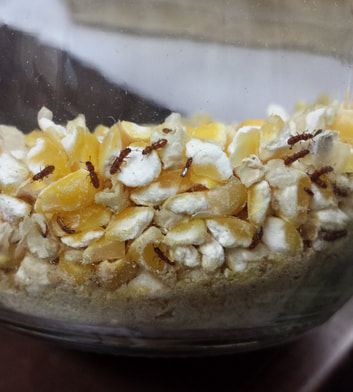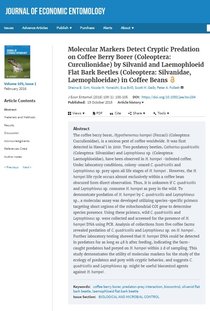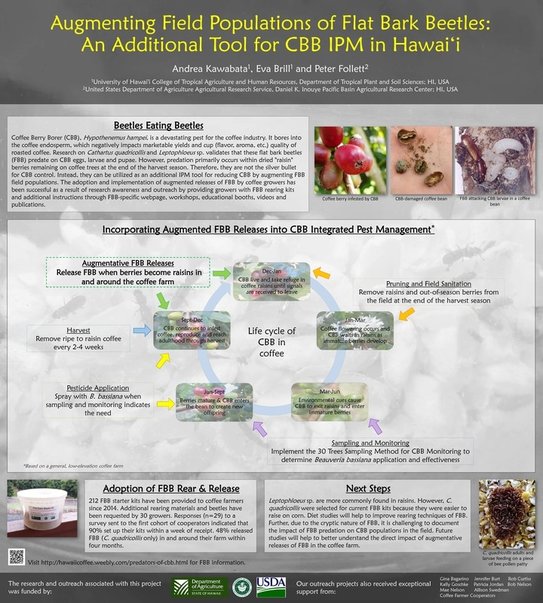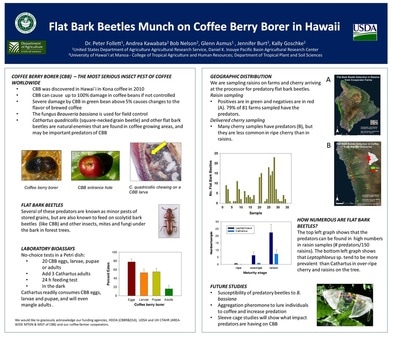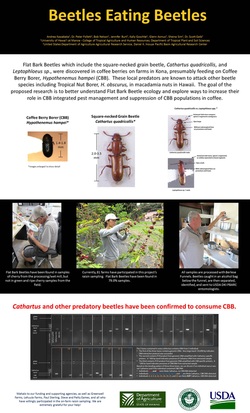The Flat Bark Beetle ProjectThis project was funded by the Hawaii Department of Agriculture and is in collaboration with the University of Hawaii College of Tropical Agriculture and Human Resources and the United States Department of Agriculture Agricultural Research Service Daniel K. Inouye Pacific Basin Agricultural Research Center.
|
Journal Publication - "Feeding habits, movement, and reproduction of the predatory flat bark beetles Cathartus quadricollis(Coleoptera: Silvanidae) and Leptophloeus sp. (Coleoptera: Laemophloeidae) in Hawaii coffee and macadamia nut" - Brill et al. (2020)
Highlights from the article:
- Various life stages of C. quadricollis and Leptophloeus sp. were found in seven different plant species common to the agricultural landscape around coffee farms, suggesting these predators are feeding and reproducing on theses hosts.
- Molecular analysis indicated that C. quadricollis and Leptophloeus sp. predated on CBB, Tropical Nut Borer and Black Twig Borer in coffee, macadamia nut, and mixed coffee-macadamia nut farms.
- Predation of C. quadricollis on H. hampei eggs placed inside artificial coffee berries in coffee farms was about 40%.
- Predators C. quadricollis and Leptophloeus sp. are natural enemies of some significant agricultural scolytine pests in Hawaii and have excellent potential for biological control with augmentative releases.
Extension Publication: "An Introduction to the Square-Necked Grain Beetle as a Predator of Coffee Berry Borer in Hawai'i" - Kawabata et al. (2016)
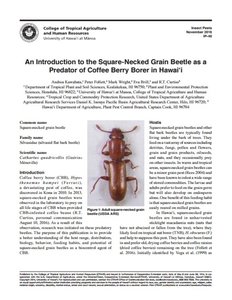
Summary of article:
The square-necked grain beetle, Cathartus quadricollis, is a predator of coffee berry borer in Hawai'i coffee. This predator is a minor stored product pest and can be reared in large numbers at low cost on cracked corn for augmentative biological control. Hawai'i coffee farmers are releasing home-grown square-necked grain beetles in large numbers. Cathartus quadricollis is not susceptible to Beauveria bassiana, a fungal biopesticide used for coffee berry borer control, so it fits well with current IPM programs.
The square-necked grain beetle, Cathartus quadricollis, is a predator of coffee berry borer in Hawai'i coffee. This predator is a minor stored product pest and can be reared in large numbers at low cost on cracked corn for augmentative biological control. Hawai'i coffee farmers are releasing home-grown square-necked grain beetles in large numbers. Cathartus quadricollis is not susceptible to Beauveria bassiana, a fungal biopesticide used for coffee berry borer control, so it fits well with current IPM programs.
Journal Publication - "Predation by flat bark beetles (Coleoptera: Silvanidae and Laemophloeidae) on coffee berry borer (Coleoptera: Curculionidae) in Hawaii coffee" - Follett et al. (2016)
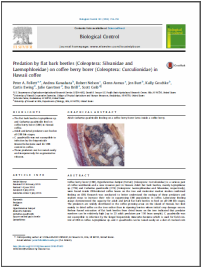
Highlights from the article:
- The flat bark beetles Leptophloeus sp. and Cathartus quadricollis feed on coffee berry borer (CBB) in Hawaii coffee.
- Adult and larval predators can feed on all CBB life stages.
- C. quadricollis was not susceptible to infection by the biopesticide Beauveria bassiana used for CBB control in coffee.
- These predators can be reared easily and inexpensively for augmentative releases.
Journal Publication - "Molecular Markers Detect Cryptic Predation on Coffee Berry Borer (Coleoptera: Curculionidae) by Silvanid and Laemophloeid Flat Bark Beetles (Coleoptera: Silvanidae, Laemophloeidae) in Coffee Beans" - Sim et al. (2016)
|
Highlights from the article:
|
Videos: Guides for Flat Bark Beetle Kits
Rearing and releasing flat bark beetles should not be considered a substitute for field sanitation, strip picking or any of the other CBB IPM recommendations.
|
A Guide To: Setting up Your Flat Bark Beetles Kit
Follow the instructions on this easy-reading guide prior to setting up your flat bark beetles. Click here for the written guide. |
A Guide To: Releasing Flat Bark Beetles for Field Augmentation
Follow the instructions on this easy-reading guide prior to releasing your flat bark beetles. Click here for the written guide. |
|
|
|
Try not to disturb your kit once you've set it up. Shaking, mixing and over-turning the kit could damage eggs, larvae, and pupae and disrupt beetle reproduction.
Reminder: You will need to purchase cracked corn and cornmeal for your kits. Cracked corn can be purchased at feed stores for a little more than a dollar a pound. Cornmeal can be purchased from a grocery store.
Reminder: You will need to purchase cracked corn and cornmeal for your kits. Cracked corn can be purchased at feed stores for a little more than a dollar a pound. Cornmeal can be purchased from a grocery store.
Year 2 Funding from HDOA for Flat Bark Beetle Research and Outreach
(Posted 6/5/15)
Thank you HDOA!!! We just received official word that our proposal to continue research on flat bark beetles and how they can be helpful towards integrated pest management of CBB has been approved.
Mahalo to all of our participants, cooperators and those who have supported us through our first year of research! We look forward to providing you with more research-based information intended to help Hawaii's farmers.
Year 2 Research Project Title "Predation by Flat Bark Beetles on Coffee Berry Borer"
Year 2 Project Objectives:
1. Determine susceptibility of flat bark beetle predators to Beauveria bassiana infection.
2. Investigate adult feeding behavior and larval ecology
3. Test effectiveness of the Cathartus aggregation pheromone lures for monitoring and behavior modification.
4. Develop better rearing techniques for Leptophloeus sp.
5. Disseminate information on Cathartus predation to coffee farmers through educational events such as workshops, field days, and farm visits, and via talks at grower meetings and extension publications.
Thank you HDOA!!! We just received official word that our proposal to continue research on flat bark beetles and how they can be helpful towards integrated pest management of CBB has been approved.
Mahalo to all of our participants, cooperators and those who have supported us through our first year of research! We look forward to providing you with more research-based information intended to help Hawaii's farmers.
Year 2 Research Project Title "Predation by Flat Bark Beetles on Coffee Berry Borer"
Year 2 Project Objectives:
1. Determine susceptibility of flat bark beetle predators to Beauveria bassiana infection.
2. Investigate adult feeding behavior and larval ecology
3. Test effectiveness of the Cathartus aggregation pheromone lures for monitoring and behavior modification.
4. Develop better rearing techniques for Leptophloeus sp.
5. Disseminate information on Cathartus predation to coffee farmers through educational events such as workshops, field days, and farm visits, and via talks at grower meetings and extension publications.
Click here for Year 1 project objectives
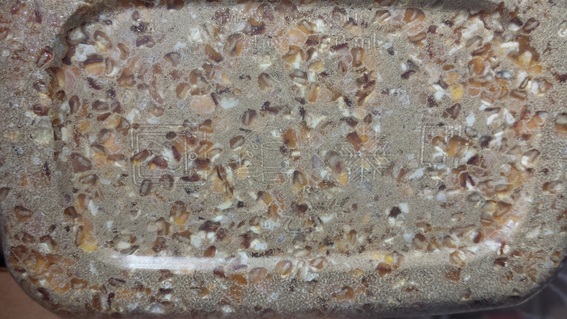
Check out all of our young flat bark beetles!
Larvae, pupae and young adult square-necked grain beetles can be seen on the bottom of our rearing container in den-like structures.
Larvae, pupae and young adult square-necked grain beetles can be seen on the bottom of our rearing container in den-like structures.
Mahalo from The Cathartus Project!!
To those who participated in the past (2/7, 3/3 and 3/19) flat bark (predatory) beetle workshops, we would like to send our sincerest aloha and mahalo to you for making these workshops an amazing success. The Cathartus Team is especially appreciative of the farm cooperators who have and continue to assist with the coffee and raisin sampling.
We could not do the research and extension work with out the help from our funding agency, the Hawaii Department of Agriculture, and supporting agencies, UH CTAHR and USDA ARS DKI PBARC. There were over 170 participants and 170 kits were given away throughout the sessions. Great turnout!!!
Mahalo also to the Sheraton Kona Resort & Spa, Pahala Community Center and UH CTAHR for their hospitality and support for our event.
For those who could not make it to the event and are interested in receiving a kit, please contact the Cathartus Project Team at the email or phone number below.
We could not do the research and extension work with out the help from our funding agency, the Hawaii Department of Agriculture, and supporting agencies, UH CTAHR and USDA ARS DKI PBARC. There were over 170 participants and 170 kits were given away throughout the sessions. Great turnout!!!
Mahalo also to the Sheraton Kona Resort & Spa, Pahala Community Center and UH CTAHR for their hospitality and support for our event.
For those who could not make it to the event and are interested in receiving a kit, please contact the Cathartus Project Team at the email or phone number below.
|
Augmenting Field Populations of Flat Bark Beetles: An Additional Tool for CBB IPM in Hawaii - Presented at the 2016 NACAA Western Region Annual Meeting and Professional Improvement Conference in Kona (Oct. 27-28, 2016)
|
|
Reproduction, feeding, and ecology of predatory flat bark beetles in a scolytine-infested agricultural landscape - Presented at the 2016 100th Pacific Branch Annual Meeting of Entomological Society of America (Apr. 3-6, 2016)
|
Flat Bark Beetles Munch on Coffee Berry Borer in Hawaii - Presented at the 2015 Pacific Entomology Conference (Apr. 1-3., 2015)
|
Flat Bark Beetles are NOT the silver bullet, nor will they solve our problems with CBB. Rather, they should be viewed as another tool that we can add to our toolbox to combat CBB and integrate into coffee farm management practices. Continue to follow UH CTAHR CBB IPM Recommendations and to strip pick your coffee and spray Beauveria to kill CBB.
Contact website management if you require any assistance with the site or information provided.
